Deadlifts can be performed by anybody and are safe for everybody, however, only on the condition that one has good form; one is flexible enough to perform this great "hip extension" exercise properly to work the lower back. If one does not have good exercise form it is because one's activities causes dispositions that produce poor postural habits, i.e., a forward head/neck with a rounded back, or bad habits in general.
Nevertheless, bad habits do not depend on nature but can be changed into good habits by practice. Democritus wittingly said, "Learning achieves fine things through taking pains, but bad things one acquires without any pains." And furthermore, "Teaching reshapes the person, and in reshaping makes that person's nature."
Temperaments Are Formed By Acquired Habits
Like activities produce like temperaments, which in turn develop into habits that make us into a particular "shape" [of body] and a particular "state" [of mind]. In other words, the activities we arrange ourselves around produce our physical shape, inner character, and mental outlook.
For example, if a person's activities reveal an inclination to lie rather than tell the truth that person will have a disposition of lying. If a person's activities reveal an inclination of inactivity that person will have a disposition of being lazy rather than being active.
Hence, our activities determine the resulting dispositions, which in turn form them into good habits or bad habits. A bad habit is one that is harmful to oneself and to others. A good habit is one that is beneficial to oneself and to others. This means that what sort of habits we form in our early years inevitably transmits to our later years, which makes all the difference—"All the difference in the world," emphasizes Aristotle.
An Acquired Habit
In my early years, at the age of 18, I acquired the habit of writing down my workouts in a "training journal." I had been training at the Gresham Athletic Club in Gresham, Oregon, for two years when I started writing down my workouts.
I wrote down my first workout on June 23, 1981, at 7:55 a.m. Since then, and like other body part workouts, I recall certain deadlifting workouts that have become memorable. Those in particular re-fuel my heart, motivate me, and give me fortitude.
What makes these workouts memorialized is that I ceased being aware of things around me. The everyday world receded into the background. My concentration focused more and more intensely when I involved myself with the results I desired from the weight of each rep of every set until my whole body was burning with the power of a raging inferno.
I recall in particular a deadlifting workout on my twentieth birthday at Wallworks Gym in Missoula, Montana, very vividly, especially my effort output and the exhilaration of the challenge (Read my 'Effort and Motivational Tools for More Productive Workouts' articles to learn more about the value for keeping a training journal).
My Deadlifting Inspiration
On October 6, 1981, at 10:30 p.m. I recorded my first deadlift workout from Riverside, California, training at my university gym while living in the dormitory. I did three sets: two sets with 205 for eight reps and one set with the same weight for six reps.
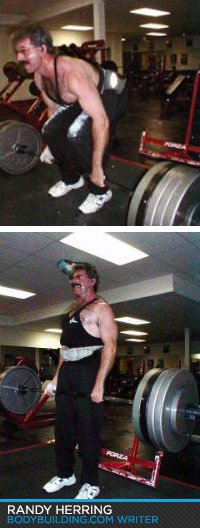
The following week on October 13, 1981, at 10:17 p.m. I wrote down my second deadlift workout. I did five sets: two sets with 205 for eight reps, one set with 255 for five reps, one set with 305 for three reps, and one set with 345 for a one-rep max. A Samoan, by the name of "Tali," said to me, "Iron Randy is back!"
By November, the following month, I was deadlifting more than 300 pounds on a consistent basis for reps. Only after one year of doing deadlifts, on September 20, 1982, the day of my 20th birthday, and weighing about 170 pounds, could I deadlift more than 400 pounds for three reps.
I attempted a 455-pound deadlift that day but I just couldn't get the bar past my knees. This was at Wallworks Gym in Missoula, Montana. After my first year of doing deadlifts I had always felt that my lower back was my strongest body part and that the deadlift was my lift.
Twenty-four years later, during the first two weeks at age 44 in September and October 2006 at Giorgio's Gym in Spokane, weighing about 190 pounds, I pulled:
- 435 for 8 reps (Oct. 3, 2006)
- 455 for 5 reps (Sept. 30, 2006 - see the picture above)
- 465 for 4 reps (Sept. 22, 2006)
- 485 for 3 reps (Sept. 28, 2006)
I attempted a 510-pound deadlift on September 20, 2006, but like twenty-four years earlier, on September 20, 1982 with 455 pounds, I couldn't get the bar up passed my knees and the weight came crashing down to the floor. See the picture above.
The 455 for 5 reps on September 30, 2006, above is significant because exactly a year ago that day, on September 30, 2005, I barely pulled that weight up for a single one-rep max. I have discovered doing multiple repetitions (what Bruce Berezay calls "marathon reps") in the deadlift rather than a single rep max is what I am good at so I stick to what works best for me that is safe and that boosts my confidence.
I still have my sights on a 510-pound deadlift but my time hasn't come yet. Going back and reading my workouts inspires me to keep moving forward as I get older nearing my mid 40s to maintain a fit mind and a strong body— a body that is living and pulsating in motion caused by a vigorous energy of aliveness through lifting weights.
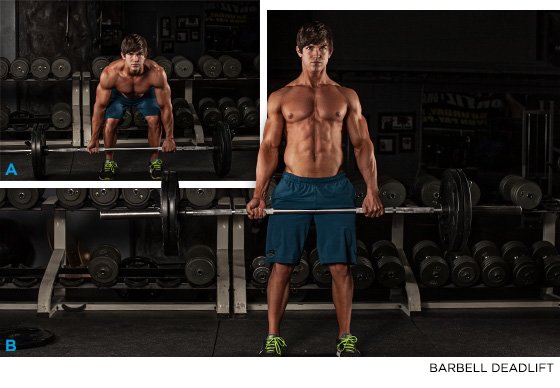
Deadlifts Stimulate The Whole Body
Deadlift is the only exercise that stimulates both the lower and upper body. The same cannot be said of squats. Deadlifts work the butt, upper thighs, hamstrings, lower back, upper middle back, traps, and gives a kind of "fullness" in the chest (take note guys).
Paul San Andres writes in Romanian Deadlifts that deadlifts is primarily a "hip dominant exercise" and "one of the best hip extensor exercises available" that works the thighs, hamstrings, and butt. Curtis Dennis Jr. writes in The Importance of the Deadlift that the deadlift, "Hits the back, the lats, the quads, the glutes, the arms and forearms, and even the abs, which proves that the deadlift produces more results than the bench press and the squats."
The deadlifts is in fact the king of exercises for expending great amounts of energy and wasting calories (take note ladies)!
Performing The Deadlift
I recommend you use a 10, 8, 6 reverse pyramid system warm-up. Take a "Romanian" close stance. Take a shoulder width grip. Grasp the bar with an over/under hand grip outside of the thighs as seen in the pictures of Bruce Berezay above. You might want to take off your lifting gloves if you are wearing any and chalk up before you pull the weight up off the floor.
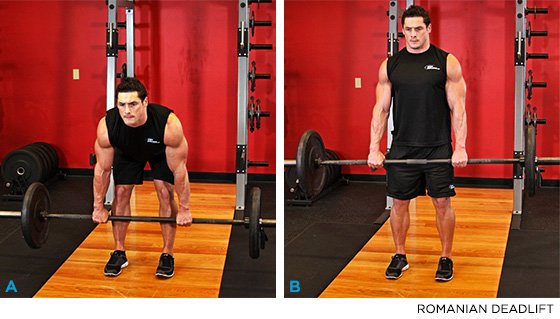
Wearing gloves can prevent you from wrapping your hands all the way around the bar for the nice tight grip that you need and also chalk does wonders for maintaining grip! While leaning forward flexing the hips and leaning over the bar grasp the bar with your knees bent (not in a squatting position).
Now ignoring all that your parents told you to do, that is, to lift with your legs and not your back, keep your head up, chest up, shoulders back, back arched, shoulder blades together, butt out, and pull the weight up— stand erect and extend the hips!
While standing erect shrug your shoulders back. Return the weight to start position. Yes, touch the floor, but do not bounce the weight; this can be dangerous to the lower back. Repeat the movement for 9, 14, or 19 more reps. Go as heavy as you can and seek to do a 10, 15, 20 rep system scheme.
If you go beyond 10 reps and do near 15 reps for your first set just plan on doing two sets total of deadlifts. Lifting more weight in a full range of motion not partial range of motion in less time is better, than lifting less weight in more time. My motto has been accomplishing more work in less time. That's intensity. That's effort. Once again, see my Effort article.
Surprisingly some authors who feel themselves an authority on the subject advise against doing deadlifts from the floor but rather from a power rack where the bar is either:
- "Just above the knee" (Paul San Andres)
- "Knee height, maybe slightly higher" (Todd Blue)
- Or "below knee level" (Francesco Casillo)
Compare the deadlifting articles by Francesco Casillo, Curtis Dennis Jr. (Curtis believes both ways, i.e., doing deadlifts off the floor or in a power rack for partial deadlifts, are beneficial), Paul San Andres, and Todd Blue. Todd Blue makes the excuse for not doing deadlifts off the floor because it involves "too much leg" and imagines his own authority admitting without knowledge of the facts in his mere 300-word article.
Francesco Casillo contradicts himself on the one hand, when he says to start deadlifts with the torso erect (hips extended) rather than the torso prone (hip flexed) as in the case of starting in a power rack or off the floor, and, on the other hand (near the end of his lengthy article), he speaks of the flexion of the hip for a greater degree of "stimulation."
He emphatically states that if the trunk or hips have a lesser degree of flexion (beginning at knee level or slightly below) then the trunk when it is extended (finishing the deadlift in an erect position) has a lesser degree of stimulation. And this is true.
However, if this is the case and it is true it is the case, Casillo is confused where to begin the deadlifts: either just below knee level starting with a lesser degree of trunk flexion, and therefore, lesser stimulation of hip extension, or farther down with a greater degree of trunk flexion, and therefore, greater stimulation of hip extension "during the upward phase."
If Casillo is not confused where to begin deadlifts then he believes both ways (like Curtis Dennis Jr.) are beneficial but favors the one starting below knee level. One cannot have both. It's either one or the other. However, teaching a novice how to perform deadlifts, thus, teaching safe execution, is in most cases best taught in a squat rack, while having the floor as the starting point—something to work toward for greater flexion to effect greater stimulation, and therefore, release greater testosterone levels (Casillo).
This is how I read Casillo's article: it is more educational than dogmatic. So I applaud Casillo for his fine and educational article.
Partial Rep Deadlifts? More Criticism
Now I want to say a few words about partial rep training in the deadlift and why it is not suitable for experienced lifters. I fell prey to this sort of "revolutionary" training method as expounded in the book Power Factor Training (PFT). Since this article deals exclusively with deadlifts I'll limit myself to talking about my experience doing PFT deadlifts.
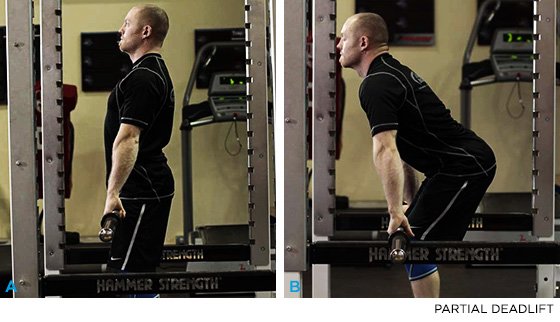
I followed the procedure as outlined by the authors and I recorded my progress in my training journal. I performed PFT deadlifts just above my knee in the squat rack. I began with 600 pounds for 8 reps on December 23, 2001 and when I terminated PFT 6 weeks later on February 8, 2002, I was up to 675 pounds for 16 reps in the deadlifts.
In my first true PFT workout on December 29, 2001, I lifted a total weight of 19,225 pounds in 50 minutes, which came out to lifting 988 pounds per minute. By "true" I mean at the end of each workout I recorded the total amount of weight lifted, the amount of weight lifted per minute, and the PF index (the higher the better).
My last PFT workout on February 8, 2002 I lifted a total weight of 99,820 pounds in 59 minutes with a PF index of 169, compared to a PF index of 52 on January 2, 2002. Impressive right? But what did PFT do for me in six weeks and after? Absolutely nothing. I was the same person as when I first started. When I went back training using full range reps I was the same size, I had the same strength, and I had the same mind.
PFT didn't benefit my body. One, it gave me a huge ego trip. Two, it gave me a false pretense that I was lifting "thousands" of pounds of weight every day I worked out. And three, it placed overly excessive pressure on my joints and spinal column and put my nervous system into over training in a very short time.
Sure, I was able to lift more weight, but only because it was in my strongest range of motion as seen in the picture of me doing partial deadlifts with 675 pounds, but all they (partial lifts) do is weaken your weakest range of motion and strengthen your strongest range of motion. It is the strongest range of motion the authors of PFT say to train in, in order to get results.
If getting results means sacrificing bones, joints, and ligaments and means upsetting the balance of the body by making the strong stronger and the weak weaker then this type of training is a farce. I am now a firm believer in the saying: "You are as strong as your weakest link."
The Perfect Rep
So what shall we say then about partial reps? Partial reps, on one hand, suggest a lesser degree of flexion, and therefore, effect a lesser degree of stimulation. Complete reps, on the other hand, suggest greater flexion, that is, greater range of motion, which effects greater stimulation, and therefore, releases greater testosterone levels.
Complete reps not only involve greater range of motion but also the appropriate rep speed of varying degrees. The perfect rep results in optimal muscle stimulation by recruiting the broadest possible range of muscle fibers to complete a muscular assignment.
A complete or full rep means starting each rep either from a fully flexed position (e.g., deadlifts starting from the floor) or a fully extended position (e.g., barbell curls). Shortening a rep stroke might allow you to handle more weight in any given exercise, but that is because you don't have to move the weight as far, and therefore, the result is that you can move more weight than you humanly thought possible.
This dupes you into thinking that you are getting stronger when you are not. Shortening a rep stroke is like a diet because it is essentially looking for a shortcut to achieve results faster with less pain. Partial reps are seductive and many bodybuilders get sucked in.
The inescapable truth is that full reps beat partial reps any day of the week. Full movements stimulate more muscle fibers than partial movements. It's simple biology—more movement, more fiber stimulation.
Deadlift Variations
Deadlifts have some variations—What is described below is the Sumo deadlift.
Sumo Deadlift
The stance is wider and you simply grip the bar on the inside of the legs with an under/over hand grip and stand erect. What was described above is known as the Romanian deadlift.
The Sumo deadlift primarily involves the hips and quads. The weak link in the Sumo deadlift is the quads and the Romanian deadlift the weak link is the lower back. Both styles have their advantages and disadvantages. The advantage of the Sumo deadlift is that you are standing more upright and seems as if you are not as close to the floor as you are as with Romanian deadlifts, and therefore, have a lesser range of motion in hip extension to stand upright than Romanian deadlifts.
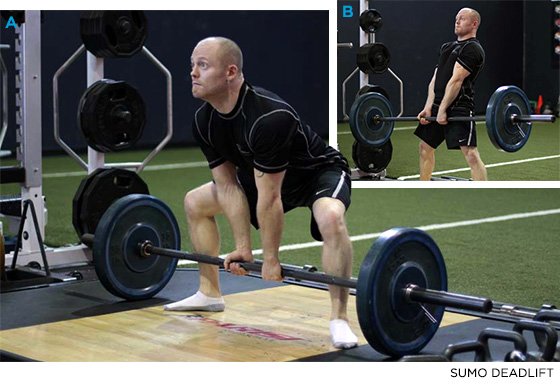
The disadvantage of the Sumo style is that it can be more hazardous, especially if one has the tendency to cave their knees in toward the floor like when one does wide leg squats or leg presses. A person with long legs like myself might be more suitable bio-mechanically for doing the Sumo style than the Romanian style. But I do the Romanian style because my joints are more stable and also because of better overall leverage in back muscularity.
In other words, I feel more comfortable doing Romanian deadlifts. The advantage of the Romanian deadlift is that the joints in your knees and hips are more stabilized because they are more centered at the core of your body and also because of better joint alignment with the knees, hips, ankles, and shoulders.
The disadvantage is that there is a strong tendency to round the lower back, i.e., curve it, and therefore, invite injury. Thus, the weak link in the Romanian deadlift is the lower back. Since I do the Romanian style, I am always telling myself: "Chest up, blades together, back arched, butt out—lift and butt down!" Do the style that best suits you physically and psychologically, and one which allows you to have near perfect form.
Conclusions
In the first paragraph of this article I talked about form and alluded to some of Democritus' ethical sayings (Democritus was a contemporary of Socrates). In the last sentence of the last paragraph above I unknowingly finished this article talking about form. There is a reason for it.
Exercise form or postural form is produced from habits we acquire. What kind of habits we acquire is not because of "human nature." What kind of habits we acquire depend on what we do, what company we hold, what we practice, and how we practice the thing we are practicing whether we are conscious of it or not.
There are no shortcuts to getting fit, learning the king of exercises, or producing great things in your life. Acquiring wealth, learning skills, cultivating your intelligences, and producing works of art takes time, sometimes more time for some than others.
One thing you can be sure of: Along your journey fine things are not acquired with shortcuts and without pain. Cultivating good habits are how good things are learned and also achieved.
